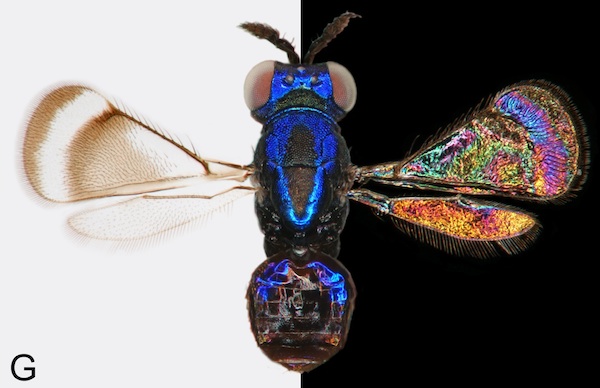Hidden in Plain Sight: 'Fairy' Insect Wings Discovered

Tiny wasps and flies look bland at first glance — like any drab brown insect you'd swat away without a second thought. But a closer look reveals a dazzling secret: Colorful wings that have gone unnoticed by scientists for decades.
Researchers at Lund University in Sweden have discovered that species of hymenoptera wasps and diptera flies that they've been studying for decades reflect light off their wings in rainbow-like patterns. The effect is a bit like oil on water, but these patterns are permanent, suggesting they may play a role in insect communication.
Scientists in the mid-1800s noticed these patterns, but shrugged them off as random and fleeting. Contemporary scientists have missed the colors entirely, Jostein Kjaerandsen, a researcher in the Museum of Zoology at Lund University, told LiveScience.
That's because lab techniques make the colors all but invisible, said Lund doctoral candidate Ekaterina Shevtsova, who first noticed the colors. "In the lab and under the microscope, we have long established traditions of viewing such small wings against a bright white background, soaked in alcohol or embedded in an oily medium on a slide," Shevtsova said. [Image of fly against white and black backgrounds]
To see the colors, she said, you have to view a living or dried-out wing against a dark background.
Kjaerandsen, Shevtsova and their colleagues published the results online Jan. 3 in the journal Proceedings of the National Academy of Sciences.
Hidden beauty
Get the world’s most fascinating discoveries delivered straight to your inbox.
Shevtsova noticed the patterns one day while working with insect specimens for her doctoral thesis.
"It's not easy to explain, because you observe many specimens every day under the microscope and you don't see it," Shevtsova wrote in an e-mail to LiveScience. "And one day you handle a specimen, which you may very well [have] seen before, and suddenly you notice the wing pattern, which is beautiful and perfect, like an art painting."
Shevtsova could tell the pattern wasn't random or chaotic, she said, and a check of other specimens showed that the patterns seemed stable within species.
"Ever since you saw it, you can't stop seeing it," she said. "It is just not possible to ignore."
She shared her discovery with Kjaerandsen, who was "flabbergasted," he said.
"It was like the world I knew suddenly was turned upside down and a totally new character system was sparkling from every wing of the flies I had been working with for years without really noticing," Kjaerandsen wrote to LiveScience.
Colorful courtship?
The wings of the flies and wasps are transparent, but they reflect about 20 percent of the light that hits them, the researchers found. It's this light that creates the shining patterns, just like a thin film of soap or oil on water creates a rainbow-colored glare.
Insects see color differently than humans, so the patterns likely look different to them, Kjaerandsen said. Patterns are similar within species and vary between species, suggesting that evolution may play a role in the artistry.
"We find it hard to believe that insects walk and fly around with wings that can be turned on to large (to them) flashing billboards without evolution picking up on it," Kjaerandsen said. "We think they are often used for communication between males and females of the same species, especially since many small flies and wasps are known to display or flash wings to each other during courtship."
The wasps and flies aren't the only everyday insects hiding beauty in plain sight. The common fruit fly, Drosophila melanogaster, has jewel-like wings as well, the researchers found. So do a variety of winged bugs in Costa Rican rainforests.
There is one notable exception to the rule, Kjaerandsen said: moths. When the researchers brushed the colored hairs and scales off moth wings, they found colorless wings beneath. That suggests that color patterns don't evolve without evolutionary pressure, Kjaerandsen said.
The next step, the researchers say, is to find out more about how insects display their wings in the wild. They also hope to learn whether evolution drives changes in the color patterns. Hidden signals such as colorful wings can also give researchers clues to the evolutionary relationships between species, Kjaerandsen said.
The study is an example of old-fashioned science yielding new information, Kjaerandsen added.
"These days, when we more and more study biological diversity split down to molecules, traditional morphological studies like this one are on the verge of disappearing from our universities – despite the fact that a major proportion of these tiny sparkling jewels are still unknown to science," he said.
- Gallery of Colorful Wings
- 10 Amazing Things You Didn't Know About Animals
- Image Gallery: Colorful Butterflies
You can follow LiveScience Senior Writer Stephanie Pappas on Twitter @sipappas.

Stephanie Pappas is a contributing writer for Live Science, covering topics ranging from geoscience to archaeology to the human brain and behavior. She was previously a senior writer for Live Science but is now a freelancer based in Denver, Colorado, and regularly contributes to Scientific American and The Monitor, the monthly magazine of the American Psychological Association. Stephanie received a bachelor's degree in psychology from the University of South Carolina and a graduate certificate in science communication from the University of California, Santa Cruz.


